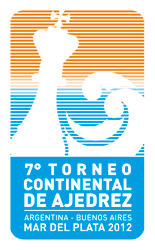 |
7th Continental Chess Tournament / Mar del Plata 2012
Tourney type: Eleven-round Swiss open
Time control: 90 minutes for 40 moves followed by 30 minutes for the rest of the game and a 30 second increment as of move one.
Location: Mar del Plata, Argentina
Dates: October 12-21, 2012
Prizes: 1st - US$5000, 2nd -
US$3400, 3rd - US$2400, 20 prizes in all, not including prizes per category.
Special: Event is considered a world championship qualifier thus all norms earned are worth double.
|
Mar del Plata 2012 : The eye of the hurricane
By Albert Silver
The second round of the ever classic Mar del Plata tournament is considered the last easy round for the stronger players, but as Shabalov would tell you: there are no easy rounds any more. Even so, this allows the higher rated players to get into gear by theoretically not having to play their absolute best while the lower-rated players still try to be the next round’s hero.
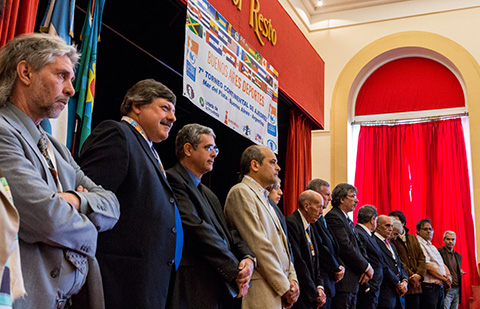
The event started with the official opening ceremony presided over by all the top authorities,
from organizers to top FIDE representatives.
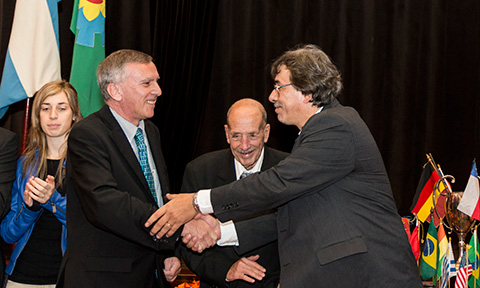
FIDE Executive Director Nigel Freeman shakes hands with Carlos Alberto Fernández,
director of the Buenos Aires Sports Cabinet,
overseen by Jorge Vega,
the FIDE
Continental President of the Americas.
While the top boards did very well according to expectations, there were a few slips, and notable ones. The first is top Argentine Diego Flores who found himself held to a draw by the untitled Brazilian Hidemitsu Cesar, but harder was American GM Gregory Kaidanov who lost to local FM Jorge Sabas.
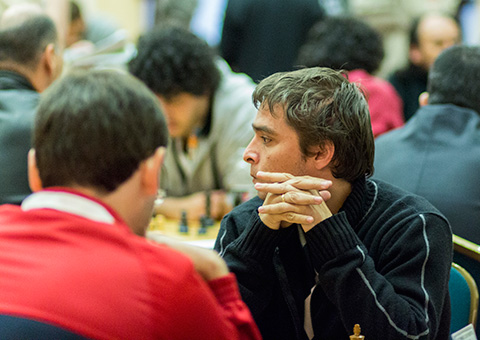
Cuban GM Lazaro Bruzon Batista has ouclassed his opponents so far

The games underway in the second hall

Argentine WIM Marisa Zuriel
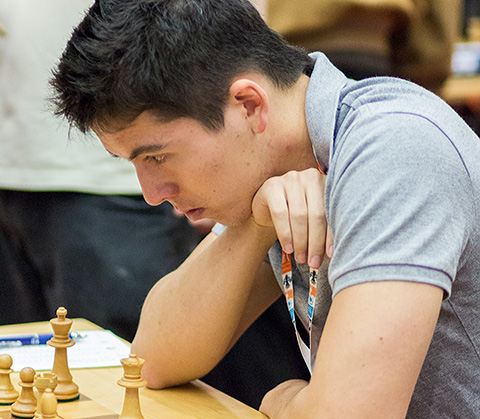
Canadian GM-elect Eric Hansen (2527 FIDE) deep in thought

Argentine GM Rubens Felgaer was very focused and won his game in spite of...

... the distracting looking Brazilian WFM Vanessa Feliciano Ebert.
Sunday will be a heavy-duty double rounder starting with round three at 9 AM and another at 5 PM, and the first leaders will begin to appear.
Annotated game by GM Sergio Slipak

[Event "VII Continental Americano"]
[Site "Mar del Plata, ARG"]
[Date "2012.10.12"]
[Round "1.3"]
[White "Iturrizaga, Eduardo"]
[Black "Ferreira, Kleber Victor"]
[Result "1-0"]
[ECO "A92"]
[WhiteElo "2639"]
[BlackElo "2121"]
[Annotator "Sergio Slipak"]
[PlyCount "69"]
[EventDate "2012.??.??"]
{In this first round, we will witness a wonderful lesson in positional play by
the Venezuelan GM Eduardo Iturrizaga, the third seed of the tournament.} 1. Nf3
f5 {The Dutch defense.} 2. c4 Nf6 3. Nc3 {White doesn't rush to play d4, since
if Black decides to play the Stonewall (e6, d5, c6), it could be useful to
play d3 instead, to fight for the e4 square.} d6 4. d4 {Now d4 is needed to
fight for the e5 square, and since Black played d6, the Stonewall is no longer
a possibility.} e6 {Nowadays this is not as common as the Leningrad, which
would have been the line had 4...g6 been played.} 5. g3 Be7 6. Bg2 O-O 7. b4 $5
{An interesting plan designed to gain space on the queenside.} Ne4 8. Bb2 a5 9.
b5 Nxc3 10. Bxc3 a4 11. O-O Nd7 12. Qc2 {Preparing the e4 rupture.} Qe8 {A
typical maneuver in the Dutch defense, to bring the queen to the kingside.} ({
If} 12... Nf6 13. Nd2 {insisting on the e4 rupture.}) 13. e4 f4 $1 {The right
way to gain counterplay.} 14. e5 $1 {Securing central space since Black is
focusing his chances on the kingside.} dxe5 15. dxe5 Qh5 16. h3 $1 {
Temporarily containing a possible attack from his opponent. An excellent
example of prophylaxis.} g5 $6 {Going astray. Since White had already prepared
against this move, this only serves to weaken Black.} ({Correct was} 16... Nc5
{with a slight white advantage.}) 17. g4 $1 {Now Black's attack stalls and
will now suffer as a result of the g5 weakness. If he wants to play h6 at any
time, he will then be forced to contend with queen invasions on the b1-h7
diagonal.} Qh6 18. Rad1 Rf7 19. Rd2 Nf8 $6 {Another mistake, possibly decisive.
The knight wants to cover the kingside weaknesses but as a result gives up
control over valuable central squares.} (19... Nc5 {was necessary though
either way White had a clear advantage. It is interesting to note how Black
neglected to take advantage of the valuable c5 square he had gained for
himself, which has cost him dearly.}) 20. Qe4 $1 {Centralizing the queen and
tying down Black's queenside.} Ng6 ({There is no longer time to redeploy to
the strong c5 square. If} 20... Nd7 21. Rxd7 $1 Bxd7 22. Qxb7 Rd8 (22... Qf8
23. b6 $1) 23. Qxc7 {and White's pawns decide it.}) 21. Rb1 Qf8 ({If} 21... Rb8
{planning b6 and Bb7, then} 22. b6 $1) 22. Rbd1 Qh6 (22... Rb8 23. c5 $1 {
taking advantage of Black's need to protect g5.}) 23. Rb1 Qf8 24. Rd3 a3 25. c5
$1 {Together with some preparatory moves, Iturrizaga finds the quickest path
to victory. Black's only choices are to either weaken himself even further and
slowly wait to be suffocated. He decides to gamble on complications, but this
only speeds up his defeat.} Bxc5 $6 26. Nxg5 Re7 27. Qc4 Re8 28. Ne4 {
Coordinating his pieces with great precision, the entry on f6 decides the game.
} Be7 29. Qxc7 Nh4 30. Bb4 Qg7 31. Bxe7 Rxe7 32. Rd8+ Kf7 33. Nd6+ Kg6 34. Qc2+
Kh6 35. Rxc8 1-0
Live Broadcast
The top boards can be followed on Playchess live.
Event partners

Copyright
ChessBase













![]()